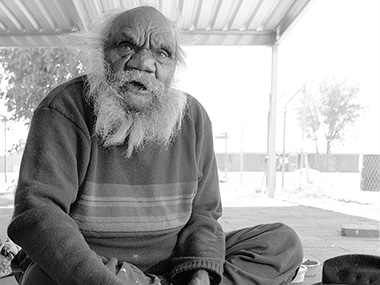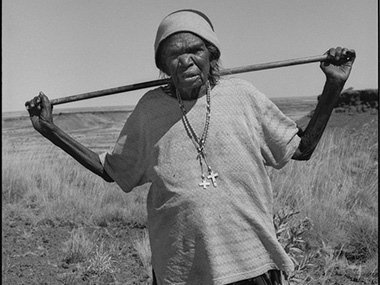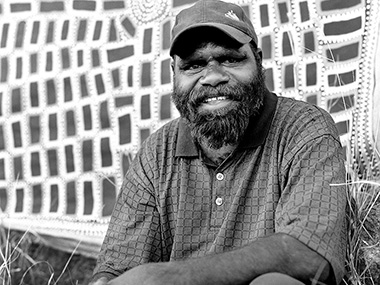Greg Weight: Stories Behind the Images

"I always feel very honoured to be in the presence of men and women like Old Bill Whiskey Tjapaltjarri" says Greg Weight (© Greg Weight)
Aboriginal Art Directory | 04.09.18
News source: Greg Weight
Note: The details of Greg Weight's life which appear here have been edited from his brief life story - used with permission. We encourage you to read this interesting story in full, and also recommend this great interview with Greg in which he discusses his philosophy and experiences. The stories behind the photographs were supplied especially for this piece.
Greg Weight’s interest in photography began in 1965, shortly after a six-month stint working as Martin Sharp’s studio assistant during his (Sharp’s) preparations for his first solo exhibition.
After Sharp had left for the UK Weight formed his own photographic studio early in 1966 and worked in advertising, fashion and theatre. But when Sharp returned in 1969 he invited Greg Weight to join him and a group of other artists in ‘The Yellow House,’ an artist’s co-op in the old Clune Galleries in Potts Point, Sydney.
It was at the Yellow House where Weight met artists Brett Whiteley, George Gittoes, Garry Shead and Bruce Goold. And it was also where he took the plunge to become an exhibiting photo media artist himself, as distinct from a commercial photographer. So on the first of September 1971, his ‘Infinity Room’ installation with photographs of Cronulla Sand Dunes opened alongside Brett Whiteley’s Bonzai Room, Bruce Goold’s Belgium Salon, George Gittoes ‘Puppet theatre and Martin Sharp’s ‘Magritte Room.’
Portraits of artists began to interest him and this coincided with his move away from the advertising market and into the fine art photography market. He describes meeting artists like Lloyd Rees, John Olsen, Rosalie Gascoigne and Arthur Boyd as like being introduced to some of the foundation blocks on which modern art in this country has grown out of. "Those artists believed that nothing mattered more than attempting to describe the indescribable, using their own unique voice. ‘We are mark makers,’ Olsen would say, and those marks are important messages to others… ‘Look at the Parramatta River,’ said Lloyd Rees, ‘it stretches up into the landscape around Sydney like the roots of a giant tree.’"
In the 1990s he went to Delmore Station in the Northern Territory at the invitation of Station owner, Don Holt. It was here he met and took his now-famous profile portrait of Emily Kngwarreye. Describing that experience, Greg says:
“Emily was surprisingly diminutive, standing approximately four feet six inches tall, she had no children and following years of working in batik which she began in 1980, she made her first painting on canvas in 1988. When I met her she was 84 years old and more than halfway through her meteoric late life rise to international stardom.
“She was like a Queen - everyone wanted a painting by Emily. When she was in the mood, Emily would sit on the ground, or tarp, under the talking tree, chew tobacco, sing her yam-dreaming story and paint canvas after canvas, day after day.
“She was supporting her whole family and much of her community. During the last eight years of her life, she painted over 3000 paintings, approximately one painting a day. In 1992, when Emily received the Australian Artists Creative Fellowship award from Prime Minister Paul Keating, she famously said, ‘Good, now I don’t have to paint anymore,’ and laughed her big toothless laugh.
“She painted ceaselessly for another four years and died in September 1996.”
On meeting 'Old Bill Whiskey', Greg says:
"Bill was sitting in the shade of the verandah at Haasts Bluff when I arrived at the station. It was a delight to find this respected elder busily working on a new painting and he pointed to the ground and patted it, which I understood as an invitation to join him.
"His name comes from being known as Whiskery Bill, due to his long impressive beard. He began painting, late in his life and he was well known before that as a traditional healer.
"He pointed to the roundels in the painting he was working on telling me they are rock holes, and these dots in straight lines meant ‘this way.’
"My photograph, Old Bill Whiskey Tjapaltjarri, was made in 2006 and despite our language difficulties, he knew exactly why I needed to photograph him and looked directly into the camera through eyes that knew more about this country that he paints than I will ever know. I always feel very honoured to be in the presence of men and women like Old Bill Whiskey Tjapaltjarri."
Not all the artists were in the Northern Territory. When he photographed Eubena Namipitjin he flew out to Balgo in the North Eastern part of Western Australia. As he had strapped himself into the passenger seat of a small four-seat aircraft which, "from all appearances," he says, "looked like it may not even get off the ground."
"‘Do you think it will make it?’ I nervously said to the pilot, who confidently replied, ‘No worries mate, this machine has done over 500,000 kilometres and hasn’t missed a beat - and besides, I have to get my flying hours up before they will let me take more than three passengers. He winked and laughed, but somehow I didn’t feel the surge of confidence I was hoping for. When we sailed over the West Macdonnell Ranges, I secretly crossed my fingers. It looked a long way down to the ground from where I was sitting.
When he arrived, Eubena Namipitjin may have thought he was a doctor as she put her arms around him and her head on his shoulder. "She had been given a blood test and was horrified at the sight of the huge needle they used. Her spirits picked up when we asked her if she would like to come for a drive so I could take some photographs. She painted Tingari stories for the land around the North Canning Stock Route and the Nyilla Rockhole, and was one of the last custodians of an ancient language. Her canvases have deep mythology in them."
But sometimes, Greg says, it is necessary to seize the moment as was the case when he photographed Walala Tjapaltjarri.
"My writer friend, Ken McGregor, had heard that Walala was staying in a town camp near Mount Nancy, just north of Alice Springs, so we headed off to see if we could find him.
"After several encounters, we were directed to where he was staying and introduced ourselves. Walala was very happy to be involved, as he was one of the prominent young artists on the rise.
"Ken sourced one of his recent paintings and we propped it up behind him for this portrait. Walala sat confidently giving the appearance of an artist who knew his time was coming."
The Aboriginal Art Directory is delighted to now offer limited edition Greg Weight portraits of Aboriginal artists. The editions are printed on cotton rag matte paper in archival inks and embossed, numbered and signed.
Share this:
»  del.icio.us
»
del.icio.us
»  Digg it
»
Digg it
»  reddit
»
reddit
»  Google
»
Google
»  StumbleUpon
»
StumbleUpon
»  Technorati
»
Technorati
»  Facebook
Facebook
Contact Details

Eubena Namipitjinpa, who may have thought he was a doctor (© Greg Weight),

Seizing the moment with Walala Tjapaltjarri (© Greg Weight)
Further Research
Artists: Bill Whiskey | Eubena Nampitjin | Walala Tjapaltjarri
News Tags: Brett Whiteley | Bruce Goold | Delmore Station | Don Holt | Garry Shead | George Gittoes | Greg Weight | Ken McGregor | Martin Sharp | Paul Keating | Yellow House
News Categories: Feature
News Archive
- 05.09.18 | The Museum Race Hots Up
- 03.09.18 | Mawurndjul Makes Headlines in DC
- 24.08.18 | Whispering Still
- 23.08.18 | Indigenous Pots Are Hot
- 19.08.18 | CIAF Sets Records
- 17.08.18 | SCHIZOPHRENIA OF THE COLONISED
- 16.08.18 | The Politics of Art in Darwin
- 01.08.18 | A SENSE OF PLACE
- 30.07.18 | The Long Forgotten Dream
- 29.06.18 | INTERNATIONAL ACTIVITY
- 24.06.18 | Blak Markets Back in Sydney
- 22.06.18 | “I am the old and the new”
- 19.06.18 | SAMUEL NAMUNJDJA
- 15.06.18 | DARK EMU
- 14.06.18 | WIK v TAREE
Advertising

